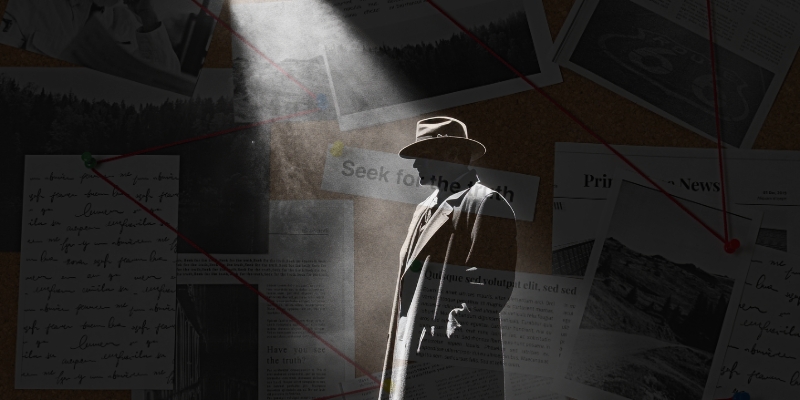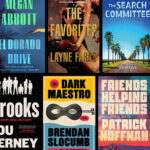I read detective novels to watch someone slowly clear away mysterious circumstances until they’re left with something neat and orderly. The story doesn’t lie in the mystery itself, but in the gradual solution of the mystery.
Sure, there are plenty of great mystery novels where the solution just sort of… unfolds, with no meaningful investigation from the main characters. I’d argue that And Then There Were None by Agatha Christie is an obvious example.
But my sympathies lie with Archie Goodwin, who has to threaten to quit six or seven times a year to goad Nero Wolfe into doing any work on an active case. Someone’s been murdered, the police are stymied, a potential witness is literally on the front stoop ringing the doorbell, and you’re just going to sit there?!
Even that most cerebral of detectives, Sherlock Holmes, never hesitates to toss on a disguise, stay up all night on a stakeout, or get down on his hands and knees to inspect a crime scene, especially in those instances when “the lust of the chase would suddenly come upon him,” as Watson puts it in “The Red-Headed League.”
The prototypical amateur detective, Miss Marple, camouflages her investigation with a flurry of normal daily activities. But be sure, when there’s a murderer on the loose, her meandering path around the sitting rooms of St. Mary Mead sharpens with a deliberateness that rivals that of a bloodhound on a trail.
These were the examples I had in mind whenever I had to plot a next move for Nikki, the amateur detective protagonist of How to Talk to Your Dog About Murder. Her goal is to solve the murder that’s exploded into her life, and that goal informs her actions.
Whenever I was tempted to allow Nikki to drift along and wait for the next clue to pop up, I’d hear impatient Archie demanding Wolfe cook up an errand for him. Even the wildest of wild goose chases is better than sitting around waiting for the murderer to make a mistake.
Now, I’m not going to try to claim that the detective has to be good at detecting. Professionals and amateurs are obviously going to flail around to different extents, but everybody’s going to spend a fair amount of time chasing red herrings and running up blind alleys.
The most suspicious looking character will have an iron-clad alibi that the detective might spend chapters and chapters trying to break. They could hash out their progress so far every morning over waffles with the person who turns out to be the murderer. They may have inadvertently solved the murder in chapter one with a throwaway joke they fail to reflect on until much later in the story.
But the investigation, whether competent or hilariously inept, should drive the plot. If they spend most of the story on the right track, we get to watch a tense game of cat and mouse as the murderer struggles to avoid detection.
A clumsier investigation might lull the target into a false sense of security, leading to revealing slips or giving the murderer the hubris to commit more crimes. It’s forgivable for an amateur detective to telegraph their next move, which might impel the criminal to clean up their tracks or attempt to silence a witness.
Likewise, any escalation on the part of the bad guy should lead to a reaction from the detective. They might redouble their efforts to solve the mystery before anything else happens. Maybe they shift the direction of their investigation, for better or worse.
They might make a wild accusation in the stress of the moment, costing them credibility with even their closest allies. Or they might give up entirely, resolving to leave the investigation to the police now that the stakes are so much higher. (Until something happens to draw them back in, of course.)
It’s much less interesting to read about a ‘detective’ who’s just out there, living their best life, while a murderer is living in parallel, bumbling around committing crimes, and the two happen to collide in the next-to-last chapter. Conflict comes from opposing forces, and stories need conflict.
Readers don’t have a ton of patience for coincidence. A passive character shoehorned into the role of “detective” is surrounded by coincidence. At the store, they run into an old friend who happens to be a key witness. During a morning jog, they stumble across the murder weapon. They mindlessly pick up a piece of litter, and it turns out to be a signed confession.
A more active character, intentionally investigating, can find the same clues, but suddenly the introduction of those clues makes sense, rather than just serving the convenience of the novel. A detective wouldn’t run into an old friend who happened to be a witness, because they would have already remembered the old friend’s connection with the victim and arranged to meet for coffee.
If the murder weapon is lying across the path of their morning jog, it’s for one of two reasons. Either the jog was always an excuse to search a trail that they determined was the most likely escape route of the murderer. Or if they really do jog along that path every morning, the weapon is a deliberate plant by a murderer hoping to mislead them or to frame them.
If a scrap of paper picked up off the ground advances the detective’s understanding of the plot, at least explain why they’re looking for scraps of paper on the ground. Maybe the victim should have had a grocery list on them, but it’s missing. Maybe a storm blew through the night before, so a dry piece of paper carefully tucked under a bench attracts the eye. Or maybe the detective finds half a dozen scraps of paper, and the detecting consists of determining which one is relevant to the murder.
Whatever the clue, ask yourself if the main character’s actions led to its discovery or the realization of its significance. I don’t care if the character is a hard-nosed police sergeant, a jaded PI, or a retired forensic pathologist. If they just happen to be standing nearby as a mystery is gradually revealed around them, I wouldn’t call them a detective.
On the other hand, if they’re actively trying to hunt down clues, they’re a detective. Doesn’t matter if they’re a nosy nursing home resident, a teenager with a photographic memory, or an out-of-her-depth pet behaviorist. They’re trying to solve a mystery, so they’re right at home in detective fiction.
Oh, and if that pet behaviorist example sounds appealing, you’re in luck! How to Talk to Your Dog About Murder is out soon, and Nikki is definitely out of her depth.
***


















